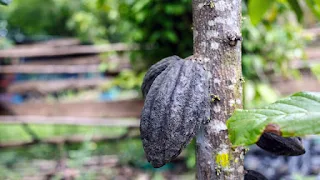A fast-spreading virus threatens the health of the cocoa tree and the dried seeds from which chocolate is made, putting global supplies of the world's most popular delicacy at risk.
About 50% of the world's chocolate comes from cocoa trees in West African countries such as Ivory Coast and Ghana. The devastating virus attacks cocoa trees in Ghana, leading to crop losses ranging between 15 and 50%.
Cocoa bud swollen virus disease (CSSVD) is spread by small insects called mealybugs that eat tree leaves, buds and flowers, and is among the most harmful threats to the root component of chocolate.
“This virus poses a real threat to the global supply of chocolate,” Benito Chen-Charpentier, a professor of mathematics at the University of Texas at Arlington, said in the paper published in the journal PLOS ONE. “Insecticides do not work well against mealybugs, leaving farmers trying to prevent the spread of the disease by Cut down infected trees and breed resistant trees, but despite these efforts, Ghana has lost more than 254 million cocoa trees in recent years.
Farmers can combat mealybugs by giving trees vaccines to protect them from the virus. But vaccines are expensive, especially for low-wage farmers, and inoculated trees produce lower cocoa yields, exacerbating the devastation wreaked by the virus.
Charpentier and colleagues from the University of Kansas, Prairie View A&M University, the University of South Florida, and the Cocoa Research Institute in Ghana have developed a new strategy: using mathematical data to determine how far away farmers can plant pollinated trees to prevent mealybugs from invading them and jumping from tree to tree. And spread the virus.
“Mealybugs have several ways of moving, including moving from tree to tree, being carried by ants or being pushed by the wind,” Charpentier said. “What we needed to do was create a model for cocoa farmers so they could know how far they could safely plant pollinated trees.” of unvaccinated trees in order to prevent the spread of the virus while keeping costs under control for these small farmers.”
By experimenting with mathematical profiling techniques, the team created two different types of models that allow farmers to create a protective layer of inoculated cocoa trees around unvaccinated trees.
“Although these models are still experimental, they are exciting because they will help farmers protect their crops while helping them achieve better yields,” Charpentier said. “This is good for farmers, as well as our global addiction to chocolate.”
Tags:
chocolate tree
cocoa trees
delicious food
dried seeds
ghana
health
ivory coast
popular delicious food
texas
virus threatens






Good
ReplyDeleteNyc
ReplyDeleteVery good
ReplyDeleteGood
ReplyDeleteBehtareen 👏
ReplyDeleteVery impressive
ReplyDeleteGood
ReplyDeleteGive
ReplyDeleteGood
ReplyDeleteGood
ReplyDeleteGood
ReplyDeleteRj
ReplyDeleteGood
ReplyDeleteGood
ReplyDeleteGood
ReplyDeleteUnfair!
ReplyDeleteGreat
ReplyDelete